Article and all photos by Joe Mock, BaseballParks.com
All rights reserved
Since the Phillies moved into Citizens Bank Park, the baseballs have been flying out of it and fans have been pouring into it. This homer haven isn’t located in a spot as special as the sport deserves, but once you’re inside, you won’t care. You’ll find more nice touches than you’ll be able to take in during a single visit to the park that has been nicknamed “The Vault.”
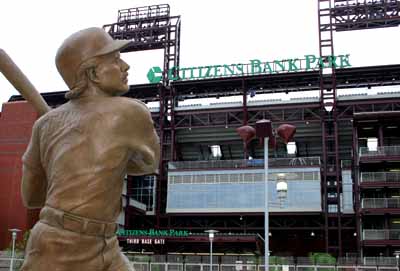 |
| Mike Schmidt’s statue ushers fans into the Phillies’ new park |
In one interesting way, Philadelphia’s new park has a decided advantage over the other new park in the Majors in 2004, San Diego’s PETCO Park. The “PR Machine” for Citizens Bank Park is almost unstoppable! It began before a shovel-full of dirt had been moved in South Philly, and continues to this day. From Web coverage to press releases to multimedia presentations to color brochures on the park’s features, the public-relations effort on behalf of this stadium is breathtaking. Of course, coming from Veterans Stadium, there’s a great story to tell about how much better everything is in the new digs!
Join us for BASEBALLPARKS.COM’s full review of the the park that made Phillie fans forget the Vet (as if that’s hard to do!).
The Setting
| Ballpark Stats |
| First regular-season game: April 12, 2004 |
| Capacity: 43,500 fixed seats, 500 permitted for General Admission |
| Price: $346 million for construction only; $458 million counting required sitework |
| Playing surface: natural grass (Kentucky Bluegrass) |
| Alternate nickname floating around: The Vault |
If you’ve read my review of Petco Park, then you know I love its location. I wish I could say the same about Citizens Bank Park, but I can’t.
After seeing what Camden Yards, Coors Field and Jacobs Field did for their respective downtowns, I became convinced that there’s no reason for a Major League ballpark to be situated in the middle of a sea of asphalt. Unfortunately, that’s exactly where CBP is located.
There are certainly reasons for this, most notably the parking and mass transit that already exists for the “sports complex” in South Philly. After all, this is where the Eagles’ new football stadium was built, and where both the new and old “Spectrum” arenas are located. It’s also where the now-demolished Vet was located. It’s just that baseball deserves to be treated in a way that is more special than those other sports, so positioning the new ballpark there is a shame.
 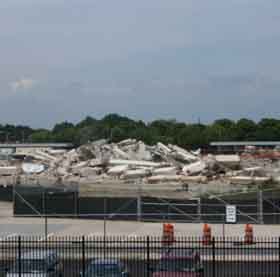 |
| Most fans’ first good look at Citizens Bank Park is going to be across acres of asphalt. And there will be more asphalt (for parking) once the remains of Veterans Stadium are completely trucked away. |
Allow me to say two more things about the uninspired location, then I promise I’ll move on! First, it’s not like there were no alternate proposals to build the park in other locations, most notably nearer downtown. Second, it’s also not like there was a “rush to judgment” that caused the current location to be selected without debate. To the contrary, I always like to point out that the Pennsylvania Legislature approved a basic funding package for new stadiums for the Steelers, Pirates, Eagles and Phillies all on the same day back in 1998. By 2001, Pittsburgh’s teams were playing in their new facilities. Construction on a new ballpark for the Phillies, though, finally started in July of 2001, much delayed due to all of the back-room bickering in the Halls of Government in Philadelphia.
| Off in the distance |
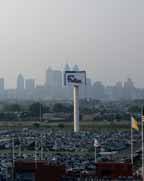 |
| If your seat is in the upper deck, you can see the downtown skyline in the distance, although the haze and a big sign mar the view. |
But by the end of 2001, construction had started, and the stadium’s regular-season debut came on April 12, 2004.
To be fair, the delays and the final decision of where to build the park were not the fault of the Phillies or the architects. Their roles in the creation of CBP are to be commended.
The site of CBP does afford good access to major highways like Interstates 95 and 76, as well as to the venerable Walt Whitman Bridge. There is also a subway stop for the Sports Complex. Needless to say, parking is not in short supply, since these are also the lots for the Eagles’ football stadium, too. There will be even more parking, approximately 5,500 spaces, once the last remnants of the Vet are finally removed and the acreage made ready.
The the footprint of the stadium was oriented to permit those in the upper deck, especially behind home plate, to see the downtown skyline. However, it is pretty far away to be thought of as a nice view of Philadephia’s downtown, plus there is a huge “Phillies” sign on a tall pole in the parking lot beyond center field that, for the moment anyway, interferes with the view. I’ve heard that the sign will be removed or moved at some time in the future.
By the way, while you’re in Philly to see CBP, take a trip across the river to Camden, NJ to visit Campbell’s Field, a ballpark with an extremely inspired location and view!
The Exterior
The Phillies’ new stadium is quite attractive from the outside, especially at night. A lot of thought went into the exterior of the facility, and it shows.
In order to achieve a “flattened” area of the seating bowl directly behind home plate (see the “Design” page for more on that), the overall shape of the stadium’s footprint is a little different than other new parks — or even old parks. Why is that relevant? Because Citizens Bank Park is essentially shaped to fit into a square city block. However, unlike old Connie Mack Stadium or Ebbets Field in Brooklyn, the foul lines don’t run parallel to two of the intersecting streets. Instead, they point northwest and northeast, with home plate in the middle of the southern edge of the block.
This unusual footprint was actually quite common — in the first half of the 20th Century in the Midwest! Otherwise, this approach hasn’t been utilized a great deal in modern times, and that’s reason enough to do it! The effect this has on the exterior of the ballpark is to create a square-ish structure, one with its bottom corners cut off to make way for the main entrances behind first base and third base. In other words, unlike most parks, there is not a main entryway behind home plate. There is a doorway there, though, that leads to the Phillies offices, suites and (downstairs) the Diamond Club seats. If you have a chance, take a look at the outside of this structure, as the word “PHILADELPHIA” is spelled out in contrasting colored bricks across the second story. If you’re not looking for it, you’ll probably miss it — which would be a shame, because it is one of the countless nice “touches” at Citizens Bank Park.
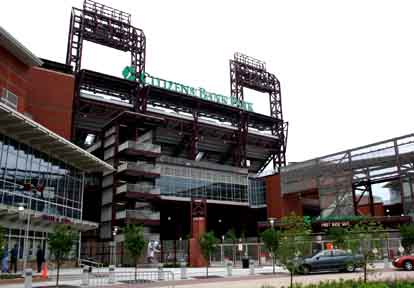 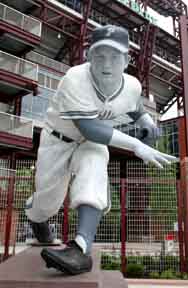 |
| The entryway behind first base features a driveway that allows fans to make a quick trip to the ticket windows (at the bottom left of the photo) or to drop off handicapped patrons. A statue of Robin Roberts, interestingly done in black and white, is just to the left of the gates. |
The two main entryways are grand, I might add. With the enormity of the structure towering in front of you, and with statues of Hall of Famers greeting you, these two sets of gates are very attractive. The one behind first base also has a very welcome driveway for dropping off fans who might otherwise find it difficult to traverse the acres of asphalt. It also makes it easy to swing by the box office to buy tickets when a game isn’t going on. Robin Roberts is the Phillie player immortalized in a statue at this entrance. A shiny bronze statue of slugger Mike Schmidt is positioned near the third-base gates.
There are also two entryways in the outfield, one at each end of the now-famous Ashburn Alley (more on this on the “Design” page). The more impressive of the two is beyond left field, and features a statue of Steve Carlton and an immense picture of the beloved Phillie Phanatic. The entrance beyond right field wasn’t used when the ballpark first opened, but the popularity of Ashburn Alley (and the fact that it opens an hour before the rest of the gates) necessitated it.
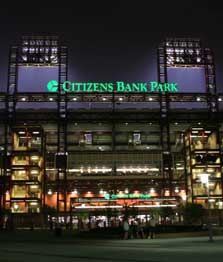 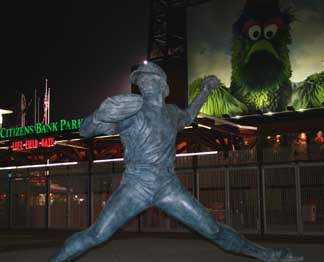 |
| The colors of the lighting at the entryway behind third base are excellent. On the right is the statue of Steve Carlton and a picture of the Phanatic at the left-field entrance. |
As nice as this ballpark looks during the day, it’s the evening hours when this place sparkles. I’m not sure I’ve seen an exterior that looks as nice at night as CBP.
While it’s true that CBP would be more photogenic if it were in a different location, you have to give a lot of credit to the architects who came up with the designs for the park’s beautiful exterior.
The Design
So at this point, we’ve established that the location of Citizens Bank Park isn’t the greatest, but its exterior is pretty nice, especially at night. It’s time to venture inside the park’s gates, and what you encounter here is what really matters, right?
You bet, and CBP really pulls everything off incredibly well. Not only is interior design very well done, it’s also a little different than you’ll find at other newer parks — very pleasantly so. Plus, its countless noteworthy details and “nice touches” are the equal of any ballpark anywhere.
The architectural team behind CBP deserves an enormous amount of credit here. EwingCole, a local firm out of Philadelphia, was the lead architect, and ballpark kingpin HOK served as “architectural design consultants.” Together, they created a stadium that contains so many special touches that it will take you several visits to discover and adequately appreciate them all.
I don’t know that the whole, in this case, is greater than the sum of its parts, but its “parts” are incredibly intriguing and are integrated extremely well into the overall design.
Let’s look first at the seating bowl. As I mentioned on the page about the park’s exterior, the area behind home plate is “flat” instead of rounded. In other words, at most parks all of the (incredibly expensive) seats in the first row behind the backstop are the same distance from the plate. This is achieved by curving the backstop. At CBP, though, the backstop is not curved. This makes a seat directly behind home plate a little closer to the batter than those to its left or right. In fact, that middle seat is only 49 feet away from the plate!
Aside from the fact that the geometrics involved tend to position all the seats so they face the infield, the overall effect of this “flat” backstop is that CBP looks like no other Major League park, especially since this “flat” angle is multiplied the farther back from the plate you go. This is one of CBP’s many distinctive features. Of course, a feature can be both distinctive and bad, but not in this case. It is a very pleasing look.
Another departure from other new parks is the lack of “cantilevering” of the upper decks. In my review of Petco Park, I observed that the steel supports for the upper deck were cantilevered out toward the field more than at any ballpark ever built. This had the dual effect of making those seats closer to the action, but also making the upper decks pretty steep so you could still see the batter.
 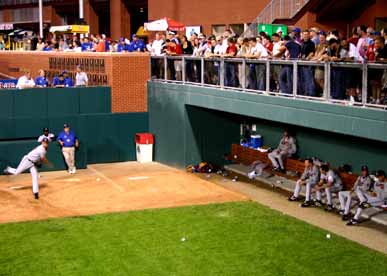 |
| The shot on the left gives you some idea of the angles in the seating bowl. Nothing is a smooth curve at CBP! Also, in the very center is “The Break” in the upper deck seats. On the right is the highly controversial visitors bullpen, with the always-pleasant Phillie fans no doubt shouting words of encouragement to the opposing relievers as they warm up. |
You could almost make the case that EwingCole had the opposite goal in Philadelphia. The upper decks at CBP are set much farther back from the field, and as a consequence, there was no need to make them nearly as steep. This also means that far fewer seats in the lower decks are located underneath the “overhang” of an upper deck. In fact, EwingCole boasts that fully 75% of the field-level seats are “open to the sky,” which is very nice. Also, to facilitate an “open concourse” (at street level, where you enter the park) behind the field seats, and so that fans can walk down to their seats, the field itself is 23 feet below street level. Before you say, “Big deal. That’s what heavy equipment is for,” let me point out two things: the water table is only 13 feet below street level at the site, and major utility lines — sewer, water, gas, telephones and three huge electrical lines — were in the way.
To say the excavation at the ballpark site was a large undertaking is like saying that Hank Aaron hit some home runs. Relocating all of the utility lines, removing 400,000 cubic yards of dirt, and keeping the site dry during and after the construction presented endless challenges. For one thing, waterproof structures had to be constructed underneath everything, and 24 “deepwells” were positioned beneath the field to take care of the water pressure (because the field is 10 feet under the water table). “The system effectively creates a ‘bathtub’ type envelope to keep water from entering the ballpark structure,” says EwingCole’s literature on the park.
One other fascinating note on the excavation: those 400,000 cubic yards of dirt had to go somewhere, and when you consider all of the environmental requirements involving this kind of work, that presented another set of challenges. Also, the site was going to have a huge hole to fill once Veterans Stadium was demolished, so the designers came up with the brilliant idea to “recycle” that dirt. They arranged for the soil to be stored temporarily at the nearby Philadelphia Naval Yard, and it will be brought back to fill in the hole once all of the debris from the implosion of the Vet is trucked away. Eventually, that site will provide close-by parking for Phillie fans.
Getting back to the seating decks … the uppermost deck, called the Terrace Level, has two other interesting features, and both involve gaps. An opening exists between seating sections down the first-base line (the Phillies refer to this gap as “The Break”) that is reminiscent of the one behind third base at the Great American Ball Park in Cincinnati. Visually, it serves a similar purpose to the two towers in San Diego, in that it breaks up the endless sections of seats in the upper deck. Functionally, it permits the uppermost deck in right field to be 20 feet lower, since there isn’t a level of Club seats there. As an interesting consequence, it also provides a small pavilion with a wonderful view of the field and seating bowl.
The other noteworthy gap on the Terrace Level is horizontal, not vertical. The box seats are separated from the upper sections, meaning even the upper level has an open concourse. This is quite unusual, and didn’t seem to do anything to harm the vantage point of the seats in the “Terrace Deck,” which is what the uppermost section is called.
| A powerful alley | |
 |
|
| You normally don’t think of an alley as being a place where you’d want to hang out. Well, when in Philly, you’d be crazy not to come to Ashburn Alley! It stretches across most of the area beyond the outfield walls at CBP, and offers some fantastic food and entertainment options. |
The outfield dimensions also deserve mention. As you would suspect at a new park, outfield symmetry has been thrown under the bus. Replacing it are funny angles, varying wall heights and some downright quirkiness. Unlike the cookie-cutter stadiums of three decades ago, the fences are not curved to achieve uniform dimensions. Instead, the outfield walls at CBP are all straight, and jut in and out in unusual places. Down the lines, it’s a fairly typical 329 feet in left field and 330 in right. However, the straight wall in left is broken up by a jog into the field (the Phillies call this “The Angle”) at a point that is 385 feet from the plate. It creates an point that is only 381 feet from home, that also starts an upward tapering of the wall height from 12 feet, 8 inches to 19 feet at a point just to the left of dead center field. This is the deepest part of the outfield (409 feet), deeper than straightaway center, which is 401 feet. The right-field wall is 13 feet, 3 inches tall, and contains the out-of-town scoreboard.
This sounds like an awful lot of quirkiness for one outfield, but I didn’t think it was overdone. The point is to create interesting bounces that will have fans, and ESPN, buzzing about the new ballpark. Besides, all of the changes in wall height and dimensions don’t come close to the insanity that is the outfield in Minute Maid Park in Houston, and that’s a good thing!
The bullpens at Citizens Bank Park have generated a lot of comment, and deservedly so. They are “stacked” like at Camden Yards in Baltimore, but the one farther from the field borders the concourse where fans can, shall we say, communicate to the players there. Originally, the home bullpen was supposed to be the upper one near the fans, but when the Phillies’ relievers saw (to their horror) how close the fans were, they were moved to the relatively isolated lower bullpen. That means that the visiting team has to warm up right next to the fans of Philadelphia who, as you know, have a certain reputation around pro sports. After some early-season confrontations that were, well, ugly, fan access to the end of the visitors pen (the area at the far end of the photo above) was cut off once the games started, and extra security was brought in to keep the peace. It’s probably only a matter of time before some really nasty incident happens here, though.
All in all, this might be an example of bringing the fans too close to the action!
In some respects, I’m saving the best design element for last. Ashburn Alley is the incredible area of games, eating places and attractions that stretches for 625 feet from beyond right field to a point behind left-center field. I’ll go into more detail on the establishments on the Essentials page of this review, but suffice it to say that it was a brilliant idea to incorporate this area within the park — and to open it to the public a full hour before the rest of the park’s gates.
Ashburn Alley, named for one of the most popular players and broadcasters in Philadelphia sports history, Richie Ashburn (whose statue adorns the middle of the “alley”), has really been embraced by the fans. The atmosphere is truly electric, both before and during the games.